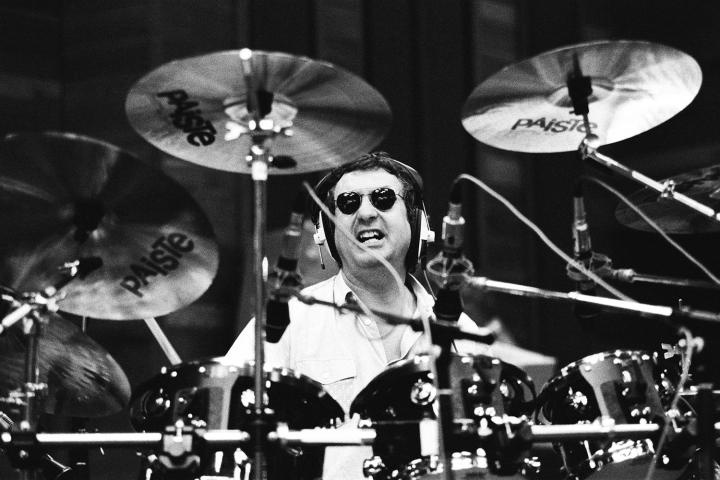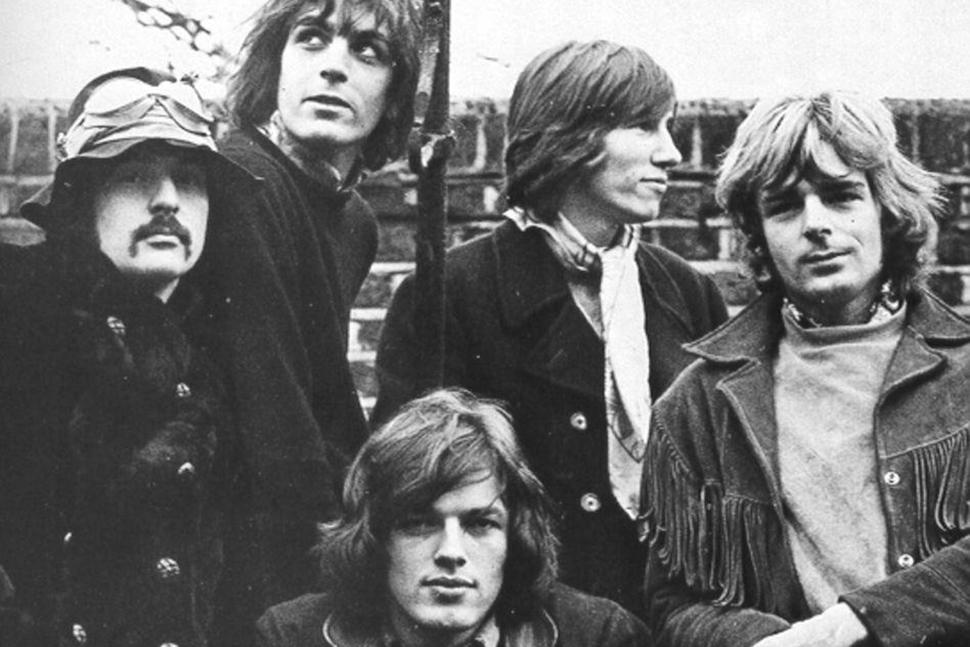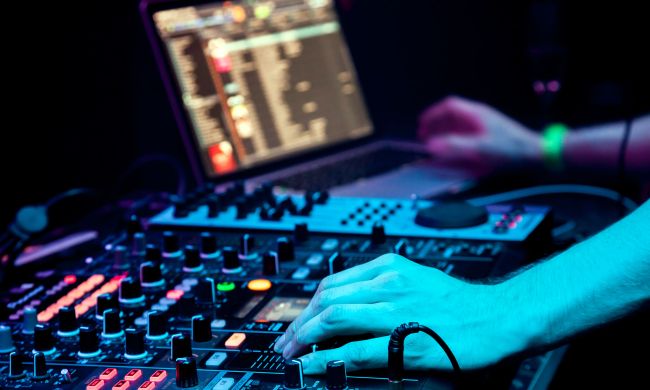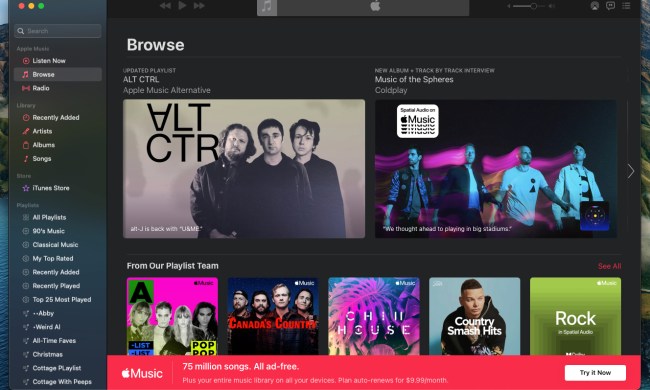
“High fidelity, first class.”
That phrase is part of a key line from Money, one of the most indelible tracks from Pink Floyd’s seminal, monster-selling 1973 audio benchmark, The Dark Side of the Moon, and it has since served as an overall sound-quality mantra for a band that set the high-water mark for just how good rock music could sound on record. Besides the gold standard permanently etched by Dark Side, the SQ scale is most notably topped by 1975’s shining aural diamond Wish You Were Here and Roger Waters’ comfortably epic 1979 madness masterpiece, The Wall.
“It was an opportunity to rediscover or rework tracks that you’d played on.”
But now, the wall is essentially complete, as what’s been deemed the band’s final album of new material, The Endless River, is released today in various formats by Columbia. River initially flowed out of the 1993-94 recording sessions that begat 1994’s The Division Bell, and it’s since been enhanced with new material created by Floyd mastermind David Gilmour and founding drummer Nick Mason, all framed beautifully by the many crucial contributions of keyboardist Richard Wright, who passed away in 2008. (Roger Waters left the band amidst much acrimony back in 1983.) Produced by Gilmour, Phil Manzanera, Youth, and Andy Jackson, The Endless River is a bold, powerful, and mostly instrumental statement, and it’s best experienced via the Deluxe Edition’s surround-sound mix on Blu-ray in 96/24 as done by Jackson, a longtime Floyd engineer/producer. I first heard River back in August while perched dead-center in front of the Neve 88R mixing console in the control room of the Astoria, the band’s houseboat recording studio moored on the Thames near Hampton, Middlesex in England, and it’s a stunning achievement absolutely worthy of the Floyd legacy.

River‘s 18 tracks have been sequenced into four specific movements, or “Sides,” and each one carries its own particular vibe, from the sweeping keyboard sturm and soaring guitar drang interplay of Side 1’s It’s What We Do, the abject percussive fury of Side 2’s Skins, the ivory-tickling solemnity of Side 3’s The Lost Art of Conversation, and the uplifting ride of Side 4’s hopeful closing statement, Louder Than Words (the latter being the only River song graced by Gilmour’s distinctive, impassioned vocals). Recently, Digital Trends sat down in New York with Floyd’s forever Grand Vizier, Nick Mason, 70, to discuss the feel of getting back behind the drum kit, setting sound-quality benchmarks, and the band’s possible future projects. Shine on, you crazy diamonds.
Digital Trends: According to Andy Jackson’s production notes, almost exactly a year ago to the day on November 11, 2013, you first got behind the kit on the Astoria to lay down your new tracks for this album. How did that feel?
“The fact that you’ve got eye contact is very different from working in, say, Abbey Road, where there’s a drum booth.”
Nick Mason: It was great. I really loved playing on this album. It was an opportunity to rediscover or rework tracks that you’d played on, and then get the chance 20 years later to review what you did and decide whether you liked it or were going to change some aspect of it — play a different fill, or whatever. It was terrific.
Kind of like uncovering “lost gems,” as you told me earlier. What do you like about the sound of that room you all recorded in on the Astoria?
For one thing, it’s extraordinary, because it’s so small.
That’s true. I stood in that room myself, and it didn’t even seem as big as it looks in the picture that’s in the River LP’s gatefold showing you, David, and Rick all playing together there.
I know! It’s tiny. You’re hard-pressed to think it would be a good place to play. But it’s the ambience of the whole boat — like the fact that you’ve got the swans passing by outside — that makes it such a cool place to work.
Is there a particular sound or feel that you got there that you can’t get elsewhere, considering the way the three of you — and later, just the two of you — were working together in such proximity?

It’s less the sound as much as the way getting the music works. You’re very attuned to listening to what other people are doing. The fact that you’ve got eye contact is very different from working in, say, Abbey Road, where there’s a drum booth. And it’s important to be that close as we get older and more short-sighted. (chuckles)
“High fidelity sound” is a phrase that’s surrounded Pink Floyd since the very beginning. I think that feel comes across quite directly in the 96/24 high-resolution downloads and the Blu-ray 5.1 version of this album, wouldn’t you agree?
Yes. And I think it’s a good opportunity to remind people that this is something that’s really relevant right now. We’ve gotten used to a diet of very poor-quality sound, which is entirely self-induced by people listening to everything on MP3 players and earbuds and so on. Let’s remember that when The Endless River came out of the kitchen, it is absolutely five-star sound.
“The concept of making quadraphonic records seemed so difficult.”
I totally concur. Are you feeling encouraged that people do seem to be listening to and embracing higher-res 96/24 downloads?
Yes, yes, I do — and I think there’s a lot more work to be done there, since there’s very interesting stuff going on with downloads today. What’s also interesting is there’s a generally accepted view that vinyl is almost the perfect version, even though that format in itself is compressed. What’s really peculiar is the human ear really seems to like that top end scraped off and smoothed off — and if that’s the case, we have to find other ways of transferring that feel to other technologies and other formats, like high-res.
In high-res, on a song like Skins — which we could also maybe call Nick’s Psychedelic Breakfast, since it also reminds me of some of what you played in 1969 on Ummagumma and in 1971 on Live at Pompeii (Mason chuckles) — you can hear all of the subtleties and sibilance of your cymbal work along with the deeper impact of your roto-toms. How did you feel about having a showcase track like that? Was it a mixture of the old with the new?

Oh yeah, it was awesome for me. And it is a mixture, very much based on something we had done twentysomething years ago. We added some fresh drums on what was an existing base. And it sounds terrific.
Have you had a chance to sit down at home and listen to it and step back from the creation process?
No, because I’ve been terrified of having a copy of the record lying around before it was released. But I did actually go down to Astoria last week and had another listen to it on proper speakers. I really enjoyed that. We’ve been dealing with anthologies and that sort of thing for a while now, so to have something new to present that sounds this good is really great.
Did you also listen to the 5.1 mix Andy did?
Oh yes. In general, that’s why Andy is so good at what he does. You don’t have to sit there and go, “Didn’t like that, didn’t like that, didn’t like that…” (chuckles) I think we’ve been very blessed with the engineers we’ve had over the years —especially what Alan [Parsons] did for Dark Side, and James Guthrie, and Andy. Funny enough, they probably represent the youngest people we’ve worked with as well.
Pink Floyd was able to maintain a live sound-quality legacy to match that of your studio work. You guys essentially created live quad in 1966; nobody had done that before. How did you feel about working in 360 degrees in general?
When you look back on it, you realize just how crude it was. It’s interesting looking at it now where you have surround in most every cinema, because, at the time, the concept seemed so complex. The concept of making quadraphonic records, and then mixing them in quad, and later surround, seemed so difficult, just to involve multitracking. But now, of course, you can have innumerable tracks, and you can assign tracks to everything. God, it makes the mixing process that much easier. Sometimes, though, one yearns for the day of the four-track recorder. You could decide it all then and there. (claps hands for emphasis)
“It’s the ambience of the whole boat that makes it such a cool place to work.”
I’ve told you this before, but I really think Meddle, and especially Echoes, would be amazing to hear in 5.1.
Yeah, oh yeah. There’s plenty of archival visiting to be done, but I have to say, at the moment, I’m enjoying not. (smiles)
Ok, let’s talk more about the new stuff. Did you have to track down the infamous gong for use in the studio?
I didn’t have to track it down — it was in my storeroom. It’s probably one of those instruments that everyone probably thought would never again see the light of day, but it was so great to get it out.
What did David say when he saw it?
He was as keen as everyone to bring it out. The feeling was, “Let’s get everything in.” So we used the chimes, the gong, and the roto-toms. I hadn’t played them in a long time, apart from when I went out onstage with Roger a few years ago, when we did Dark Side [during about a dozen shows on Waters’ The Dark Side of the Moon Live Tour in 2006-07]. They needed a bit of dusting off.
How did it feel playing them again?

Great. I mean, you forget what they sound like. You get used to electronic drum kits, which are very similar to the roto-tom. Electronic kits now are fantastic, but there’s something about a roto-tom where you can spin it and get the tone out that you need.
There’s a certain aesthetic to that “real” kind of sound that you can’t get with programming.
Acoustic instruments are endlessly fascinating. Real pianos, acoustic guitars, and drums are extraordinary — they do things electronics and sequencers and programmers just can’t do.
That makes me think of Rick’s Royal Albert Hall organ moments on Autumn ’68 [recorded June 26, 1968, the night Pink Floyd was banned from ever playing at the Royal Albert Hall again after letting off cannons and nailing things to the stage itself, among other things].
“We’ve gotten used to a diet of very poor-quality sound, self-induced by people listening to everything on MP3 players and earbuds.”
That was an extraordinary thing. I had no idea that existed. I suppose I feel that is one of the gems, much like the one on Wish You Were Here with Stéphane Grappelli [a version of the Wish You Were Here title track on both the 2011 Immersion box set and Experience edition that showcases the legendary classical violinist Grappelli taking a solo]. I thought we had lost that one — that we’d run out of space and recorded over it. To find that one really pleased me. It’s amazing. And the great advantage of digital technology now is you just save everything.
Andy told me a lot of the stuff from the Division Bell era was stored on DAT. Luckily, nothing was lost or ruined.
And it’s a pity that’s it gone now, because DAT was a really good format. But the trouble with DAT is that the tapes could get damaged. But then again, even hard drives aren’t all that reliable.
True — and the almighty cloud could even blow away at some point.
(laughs) Someone will hack into the cloud and rework everything you’ve done, and put terrible lyrics on your songs.
Obscured by Clouds, quite literally.

(laughs heartily) Oh yes.
Last time we talked, we went over some other potential archival Pink Floyd projects. One of the things you mentioned that you wouldn’t mind seeing would be the Syd Barrett era of the band [1965-68] getting special treatment. Is that still the case?
I really do think that would be interesting, yes. There’s perhaps mileage in looking at that sort of project, given what’s available now, in terms of what could be done visually. Over the last year or two, I’ve been archiving what there is in terms of footage — sometimes Super 8, which is really crude — but it would be fun.
Thanks to YouTube, people can easily find grainy clips of you all on the beach with the mannequins in the “Arnold Layne” promotional film [shot in February 1967 on the beach in East Wittering, West Sussex, England].
Right. It’s a long time ago now, and we all looked different then. I like to remember where we came from, and what we looked like when we did. That could be really good fun to put together as a project.
“We used the chimes, the gong, and the roto-toms.”
What else can you say about the footage you’ve found?
We found scraps of film of the one or maybe two gigs we did with Syd and Dave together. Not onstage, I mean — just us messing around. And, of course, there’s stuff that came from French television when we were out promoting, with Dave miming to Syd’s singing [on February 22, 1968, on a show called Bouton Rouge, where Gilmour mouths Barrett’s lead vocals on “Astronomy Domine” and “Flaming”]. That sort of thing I think is relevant and interesting.
I vote yes for anything like that to be nurtured and released! In your autobiogaphy, Inside Out, you made mention of David’s idea for a “twist on the unplugged concept” [page 335] that was never finished. Did anything ever come of that?
The problem with that is it never really went anywhere. It was something that had interest, and we talked about it a bit. (pauses) We probably should have done that some time ago. But we really needed the three or four of us to make that happen.
Ok. Well, if we have to call this new album the end —
The Nearly Endless River, yes. (both laugh)
When you were listening back to it, you must have felt comfortable enough to say, “This is a good final statement for the band.”
It’s a slightly more graceful bow out than just leaving it with The Division Bell. But it’s very difficult for any of us on the inside to judge ourselves. We rely on people outside to tell us.
Ok, I’ll tell you — I think it’s quite a worthwhile postscript. Last thing: If somebody puts a Pink Floyd record on 100 years from now, what will they think of it?
Oh, God knows. It depends on how important music still is 100 years from now. We’re living in a world of music being devalued currently. Fifty years ago, music was very important. Hollywood had sort of slipped a bit, and music was front-page news — like whatever The Rolling Stones were having for breakfast.
But having said that, it does look like music is coming back. There’s an enormous enthusiasm to play it. So it’ll be great in the future — but it won’t be great for me, because I probably won’t be around. It’ll be my children’s children’s children who will look at it and say, “Oh, my great grandfather did that.”
(Images courtesy of Pink Floyd)











